2006 Butlins Mineworkers Open Brass Band Festival - Test Pieces
16-Jan-20064BR has a look at the set works and composers that will test the bands at Skegness on the weekend.
 Championship Section:
Championship Section:
St Magnus – Kenneth Downie
This music is a set of variations on the tune known as St Magnus, which is attributed to Jeremiah Clarke. Most people will associate it with Thomas Kelly's hymn which begins: "The Head that once was crowned with thorns Is crowned with glory now".
The tune is very simple, consisting of just two, four-bar phrases. Neither is there much in the way of rhythmic variety, every note being a crotchet with the exception of two quavers, and the last note in each phrase. Within such a simple structure, however, lies considerable strength.
Theme:
The listener is given the opportunity of hearing it twice, in full, at the beginning, starting with one player but soon taken up by the full ensemble. It returns in the middle of the music and is stated again near the end. This has been done quite deliberately in the hope that there will be an appreciation of what material is being developed, by the listener as well as by those with access to the score, who are able to see the visual connections.
Variation 1:
This takes the rhythm of the last part of the theme and also uses the shape of the opening as a recurring figure. The mood is whimsical and skittish, with short, teasing rhythmic figures tossed around the band, and quick interplay with percussion, at a fast tempo. An energetic flourish finishes this variation before the Andante espress.
Variation 2:
This commences with chords related to the opening of Variation 1. The cantabile on solo cornets establishes a new, lyrical mood and there is scope for expressive playing in a series of short solo passages. The theme works its way unobtrusively into the texture before a reprise of the solo cornet melody and some more lyrical interchanges between Eb tuba, euphonium, flugel horn and cornets. The variation ends serenely with clear references to the last phrase of the theme.
Variation 3: Allegro con moto
The first idea to dominate is clearly linked to the shape of the theme's first phrase. There is a frenetic feel to much of this variation, with considerable energy and instability created by extensive use of cross-rhythms. A thinning-out of the score marks a clear change to development of the start of the second phrase of the theme. This proves to be short-lived however, and the opening material returns leading to a restatement of the theme, "Maestoso" after which a euphonium cadenza links to:
Variation 4:
Here we have some solos for euphonium, cornet, trombone and tuba set against a background of horns and baritones presenting a pensive statement of the theme's opening.
Variation 5:
This commences Allegro, with lively work for cornet and euphonium spreading to the whole band before attention focuses on the beginning of the second phrase of the theme which is initially presented in diminution, then in regular rhythm, then in inversion. An increase in tempo coupled with a decrease in volume, requires dexterity and control, with several metrical challenges thrown in for good measure. The same fragment of phrase becomes an ostinato which generates a frenzied climax, punctuated by short, dramatic silence, before the opening figure returns and the music gradually winds down.
The tubular bells herald the final return of the theme, in augmentation, marking the start of the:
Finale:
With the running semiquavers of the previous variation sounding in counterpoint. A fast, furious coda speeds the work to a conclusion while references to the opening of the theme are still trying to break into the texture of the music.
Kenneth Downie
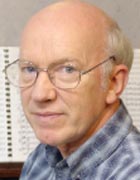 Profile: Kenneth Downie
Profile: Kenneth Downie
Kenneth Downie was born in Glasgow in 1946 and educated at Greenock High School, the Royal Manchester College of Music and Durham University. He then became a specialist music teacher in schools before finally leaving his position as head of music at Poole Grammar School to go into the jewellery business in 1976.
His published compositions, now numbering over 70, many of which has been recorded and broadcast on national radio, span a period of 30 years and are mainly for brass band or choir. In 1997 and 1999 his ‘Purcell Variations' and ‘Music for the Common Man' were chosen as section one regional test pieces for the National Brass Band Championships. In 2001 his ‘St. Austell Suite' was the section three test piece.
In April 1998 he was appointed Composer in Residence to the Yorkshire Building Society Band and thus began a fruitful relationship involving concerts, broadcasts and recordings.
In July 2001 he was appointed creative music consultant to the Salvation Army, working for three days each week in the Music Ministries Unit of the Evangelism Department.
With his wife Patricia he established the music publishing company 'Kantaramusik' in 2001. Kenneth lives in Winchester with his wife Patricia, also a musician who teaches pianoforte and singing, and they are both active in the Salvation Army Church, Kenneth being Bandmaster and Patricia Songster Leader.
Kenneth's involvement in the Salvation Army Music Scene has afforded him the opportunity to travel throughout the world as, along with his wife, he has been involved in music schools and clinics in the USA, Canada, France, Sweden, and Holland.
The Scottish Brass Band Association were delighted when Kenneth accepted the commission of the 2004 European Championship test piece.
First Section:
Purcell Variants - Peter Meechan
Purcell Variants is based on Purcell's Queen Mary's Funeral Music, which consists of 4 canzonas (for brass), 2 elegies and an anthem.
The first movement begins by sounding some of Purcell's original music in the trombones, underpinned by a timpani roll with the cornets articulating the beginnings and endings of the phrases. This leads into a cadenza for cornet and horn before the movement heads in different directions, leading us to its mysterious end, where the original music is sounded this time in the 'stabs' of the muted cornets.
Originally composed for the funeral of Queen Mary in 1695, Purcell's original funeral music was used later that same year for Purcell's own funeral – he died aged only 34. The second movement is an elegy, inspired by this story.
After an introduction (started by cornets sounding a last post), the main melody of the movement is introduced by the solo euphonium, with other solo roles for an off stage soprano cornet, and trombone. This is then taken over by the cornets who lead us into the middle section of the movement.
The middle section is a quasi funeral march, inspired by the image of Purcell's coffin being taken to its final resting point. The main melody returns in the euphonium, flugel and soprano cornet, this time more elaborated, and the movement ends with a snare drum fading away – perhaps a metaphor.
The Finale is a fast and furious movement combining thematic material from the two previous movements with new rhythmical ideas. This takes us through to the final passage - the triumphant return of Purcell's original theme.
Purcell Variants was composed in 2004, for the Black Dyke Band and is dedicated to their musical director, Dr. Nicholas J. Childs. The first performance was given by Black Dyke Band, conducted by Dr. Nicholas Childs at Bridgewater Hall, Manchester on 4th September 2004.
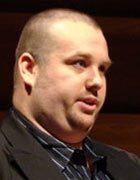 Profile: Peter Meechan
Profile: Peter Meechan
Peter Meechan (b.1980) graduated in 2002 from the Royal Northern College of Music, after studying for four years with Anthony Gilbert (and for a short period, Elena Firsova). On graduation, he was awarded the Edward Hecht prize for composition.
His music is strongly influenced by jazz, especially the post 50's era of Miles Davis. Amongst other influences, Peter lists the music of Stravinsky, Andriessen and Pink Floyd. In May 2003, Peter was appointed as the first ever 'Young Composer in Association' at the prestigious Black Dyke Band. September 2002 saw a performance of 'Crazy Diamonds Shining' by the City Side Symphony Orchestra, London - a concert marking his appointment as composer in residence with them.
Ensembles, conductors and instrumentalists who have played his music include; James Gourlay, Clark Rundell, David Thornton, Rob Buckland, RNCM Wind Orchestra, Fodens (Courtois) Brass Band, RNCM Brass Band, City Side Symphony Orchestra, Warwickshire County Chamber Orchestra and the RNCM New Ensemble. Peter has had works performed at the National Lower Brass Day, RNCM Festival of Brass, the ITG (International Trumpet Guild), the ITEC (International Euphonium and Tuba Conference), BASBWE 2003, and the Edinburgh Festival .His music has been performed in several countries, including: Portugal, the Czech Republic, New Zealand, the Republic of Ireland and the USA. He has also been broadcast on Portuguese television. Peter won the second prize in the British and International Bass Forum composition competition 2001, with his piece Word of Mouth (Inner Vision).
Second Section:
Prometheus Unbound – Sir Granville Bantock
A Symphonic Prelude after Shelley
An extraordinary composer, Bantock composed in so many styles that he never truly found one of his own. His works are uneven too; even within the band repertoire he ranged from the banal Kublai Khan through the trivia of the Oriental Rhapsody to this superb music.
Shelley's enormous poem is not contained within the ten minutes of music here. The atmosphere, though, is wonderfully achieved. From the outset we have tremendous tension over the underlying rhythmic fours, some slow and some quicker, building to a colossal statement where the ends of the band converge upon one another.
Within simple, almost primitive, scoring there is a wealth of detail – that dolce cornet answered by an espressivo euphonium is a stroke of near genius. Individual virtuosity is rarely required by this score. Instead it demands extraordinary organisation and control of mood and tempo, perfection of balances and intonation; a demonstration, at its best, of the wonderful sounds within the brass band.
In economy of means combined with wealth of ideas, Prometheus Unbound rivals, Holst of five years earlier. Like that work it is neglected because within its apparent simplicity lie enormous difficulties.
The music is much influenced by Sibelius, whose music Bantock championed in Britain. The coda contains a quote from the Second Symphony of the great man.
Bram Gay
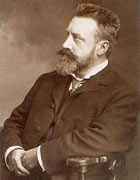 Profile: Granville Bantock (1868-1946)
Profile: Granville Bantock (1868-1946)
Granville Bantock was originally intended for the Indian Civil Service. The son of a Scottish doctor, he was born in London in 1868 and turned to music relatively late in adolescence, entering the Royal Academy in 1889 after a period of Trinity College of Music.
Under his teacher Federick Corder, a former pupil of Hiller in Cologne, he did well enough to have a number of his student compositions performed at the Academy, including a one-act opera, Caedmar, and Egyptian ballet suite from the incidental music to his own play Rameses II, a dramatic cantata, The Fire Worshippers, and Wulstan, a scena for baritone and orchestra, all marks of his very considerable ambition.
In 1893 he left the Academy and for the next three years edited The New Quarterly Music Review, while serving as a conductor for performances of light music, directing musical comedies for George Edwardes in a world tour in 1894 and 1985 and Stanford's opera Shamus O'Brien. He followed this with an ambitious London concert devoted entirely to the music of contemporary British composers, most of whom are now forgotten, except for Bantock himself.
In 1897 Bantock became conductor at The Tower in New Brighton, where he remained for four years, taking the opportunity to do what he could to encourage British composers in a musical establishment of limited possibility, augmented in 1898 by the foundation of the New Brighton Choral Society. In 1900 he conducted a programme of British music in Antwerp, including first performances of some of his own compositions, among which was the symphonic poem Jaga-Naut, intended as the second of 24 projected symphonic poems, based on Robert Southey's poem The Curse of Kehama. Later tone poems followed, generally with some declared literary derivation.
In 1900 Bantock became principal of the Birmingham and Midland Institute School of Music, following Elgar as Peyton Professor of Music at the University in 1908, appointments which inevitably drew him into the musical establishment, leading in 1930 to a knighthood. The system of musical training he advocated involved a much wider education than is usual for music students and included general literature, mathematics and languages, a sign of his own breadth of interest, reflected in the variety of his compositions and in particular their wide literary terms of reference.
These included the monumental setting of Edward Fitzgerald's translation of Omar Khayyam, a work in three parts that was first heard at music festivals in England and Wales and in 1912 received a successful performance in Vienna. His subsequent involvement with competitive festivals in England led him to write a considerable amount of music for this purpose. He retired from his position in Birmingham in 1934, continuing thereafter his activity as a composer, a conductor and an examiner for Trinity College of Music.
Sir Thomas Beecham, eleven years Bantock's junior, saw his gifts as principally operatic, praising what he describes as a "flow of genial melody, unmistakably of the ‘stagey' sort, a solid but lively handling of the orchestra, and a by no means too common capacity for passing swiftly and easily from one contrasting mood to another", finding in him one of the two outstanding figures in English musical life. Bantock died in 1946
Third Section:
A Royal Mile Suite - Alan Fernie
A Royal Mile Suite was the third section test piece during the Dutch Brass Band Championships in 1997. The four parts of this expressive suite reflect the atmosphere and character of Edinburgh's High Street, the Royal Mile. The parts are entitled: At the Palace Gates, Holyrood Park, Jenny Ha's Reel and March: Castrum Dun Edin.
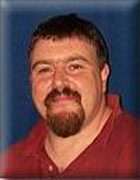 Profile: Alan Fernie
Profile: Alan Fernie
Alan Fernie hails from Newtongrange, where he joined the local brass band as a youngster. He went on to study trombone at the Royal Academy and played for many of Scotland's leading orchestras.
Today, he is best known as one of the UK's leading arrangers and composers of brass band music. It is virtually impossible to find a brass band anywhere in Britain that has not played at least one of Alan's arrangements, and he continues to be asked to write new material for the UK's leading brass bands (e.g. arranging numbers for the celebrated Brass in Concert championships at Spennymoor).
Meanwhile, his work as a conductor has taken him all over Scotland and abroad. He recently travelled to Norway to conduct a band in the Norwegian Championships. Having first taken up the baton at Jedburgh some two years ago, Alan Fernie has lifted the standard of the band enormously. Alan is a consummate entertainer, and is extremely popular with band members and audiences alike.
Fourth Section:
A Cavendish Suite - Iain Rayner
"A Cavendish Suite" is based upon the historic ‘Bolsover Castle' in Derbyshire and depicts scenes from the picturesque castle itself. The ‘Cavendish' family owned the castle for several centuries hence the title "A
Cavendish Suite".
An unlikely miracle,' wrote the historian and champion of the Castle, Mark Girouard, 'the keep at Bolsover has survived into this century as an almost untouched expression in stone of the lost world of Elizabethan chivalry and romance.' The house you see today stands on the site of a medieval castle built by the Peveril family shortly after the Norman Conquest. Sir Charles Cavendish bought the old castle and began work on his 'Little Castle' project in 1612. His creation - despite its embattled appearance - was not designed for defence, but for elegant living. Sir Charles intended the house as a retreat from the world to an imaginary golden age of chivalry and pleasure.
His son, William, who later became a Duke, inherited the Little Castle in 1616 and set about its completion, assisted by the designer John Smithson. William then added the stately rooms of the Terrace Range and, in
1634, invited the Stuart court to a masque specially written for the occasion. Finally, William constructed the enormous stables, in which he indulged his passion for training horses.
The symbolic and erotic wall paintings in the Little Castle, some of which were restored in the 1970s, have been carefully conserved. The castle battlements and the Venus Garden have been restored and the fountain, with 23 new statues, plays again for the first time in centuries. The stables have been developed into a newDiscovery Centre. Bolsover Castle regularly hosts living history events, open-air concerts and Shakespeare plays. It also has an interactive audio tour and audio-visual displays. In 2001 the castle was voted Heart of England Tourist Board Visitor Attraction of the Year.
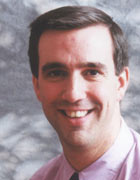 Profile - Iain Rayner
Profile - Iain Rayner
Iain was born in Northampton in the East Midlands and brought up in the Salvation Army where he started playing the cornet. He later moved to Bedford and changed instrument to euphonium in the Army band. Here he progressed to play in Bedfordshire County Youth Concert and Brass Bands and also in the Salvation Army's East Midlands divisional youth band. On gaining his A levels and leaving school he joined the band of Her Majesty's Life Guards in the Household Cavalry.
Here he took part in many prestigious events including Trooping the Colour and the Lord Mayor's Show. After leaving the Army Iain joined the Salvation Army's renowned Kettering Citadel Band where he became Deputy Bandmaster. Iain began writing music for Salvation Army bands and in 1996 enjoyed his first success when one of his arrangements was played at the Royal Albert Hall by the Army's International Staff Band. He later began writing for the wider brass band world and in 2000 won the NABBC composer's competition with his original concert work 'Tsunami'. Iain has since had a number of works published for brass bands and most recently was a prize winner in the final of the 2002 European Young Composer's Competition with his work 'Eclipse'.
He recently completed his honours degree in Brass Band Studies at Accrington & Rossendale college studying with Richard Evans, Arthur Butterworth and Darrol Barry. Here he was awarded both the composition and conducting prizes. Iain is now enjoying success writing for some of the top players in the brass band field including David Daws, internationally renowned cornet soloist, Melvyn Bathgate, principal horn of Brighouse & Rastrick band, Donna Lewis, principal horn of the Leyland Band and Gary Fountain, soprano soloist with the Travelsphere Holidays Band.
Iain is married to Jan and they have two girls, Peta and Gemma, and is a Primary School teacher.















